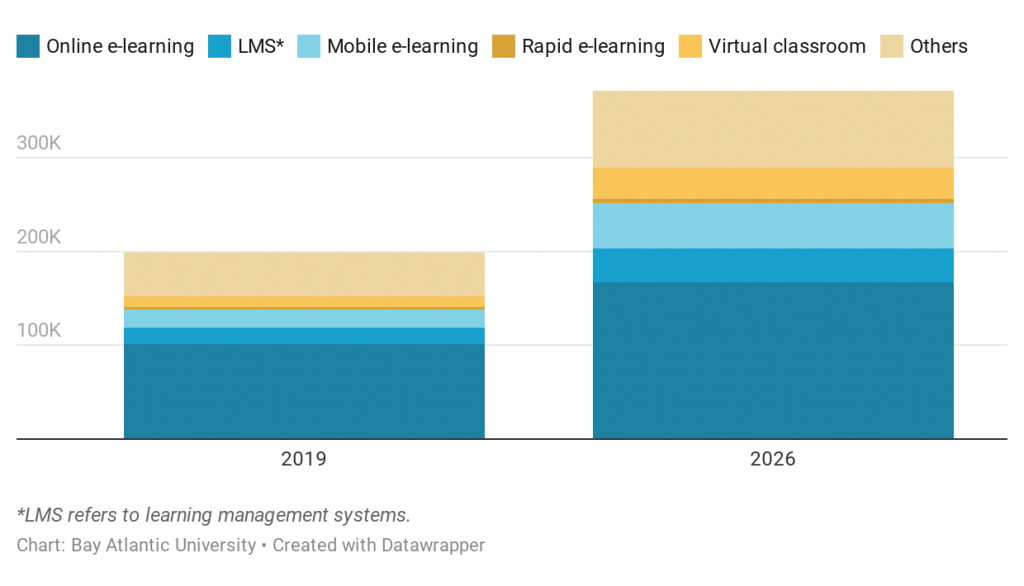Online education—the ever-growing popular alternative to traditional classes.
We see it almost daily as an option for all educational levels. However, what does it really mean to learn online? What contributed to online learning becoming such a welcome practice in education? What are the advantages and disadvantages of online learning?
From students’ preferences, affordability, and COVID-19 restrictions, here’s what online learning entails and how it’s expected to change.
What is Online Learning?
Essentially, online learning is a relatively new form of distance learning which takes place online. It utilizes technology, psychology, sociology, and business to bring a more effective model for overcoming obstacles that traditional learning faces.
For instance, online education is often more affordable than brick-and-mortar education, by merely taking out housing and commuting. However, with the lack of face-to-face communication with both peers and professors; to some, cutting costs is not reason enough to switch.
Given that, full-online education is not the only option.
How many types of online learning are there?
Online learning is grouped into four main categories; tech-enhanced courses (TEC), minimal face-to-face courses (MNF2F), fully online courses (ONLINE), and hybrid or blended courses (HYBR). Let’s talk about what these categories represent.
TEC refers to classes that employ technology, such as learning management systems (LMS), to support both learning and teaching. In most cases, some content material and a syllabus are provided online for students to have access 24/7 to it.
MNF2F classes take place almost fully online, where face-to-face meetings are slim to none. The odd few that do take place are regarding introductions, reviewing work, and examination.
ONLINE are 100% online classes. They are delivered through an LMS and are known to use synchronous and asynchronous tools often when it comes to student-professor communication.
HYBR is a term used to describe classes in which online course activities replace at least 30% of required face-to-face meetings. Typically, when some time spent in the classroom is supplemented with technologies used for education and communication outside the classroom, thus subtracting the amount of time spent in a classroom, it’s called a hybrid course.
Online Learning in the U.S. & COVID-19 Impact

[CLICK HERE TO SEE THE FULL SIZE INFOGRAPHIC]
How Effective Is Online Learning?
To answer shortly, there is no definitive response to this question.
However, online learning does have its advantages and disadvantages. For some, it may be more effective than traditional classrooms; for others, it may seem like a waste of time to get an education online, and believe they benefit more in a face-to-face setting.
For online learning to be effective, there are many factors that need to be thought out and issues that educational institutions must be ready to tackle. Let’s see what the strong points and drawbacks of getting an online education are.
Pros & cons of online learning
While online learning benefits are numerous, there are also a few weaknesses that come with it turning it into a potential threat to the success of any kind of classroom. Keep in mind that even something minor on a large scale, such as a student’s learning style can influence the way they feel about online education largely.
So, what makes online education good and/or bad?
Read on to find out.
It can take place anywhere
One of the main online learning benefits is that students don’t have to attend class physically. They can be practically anywhere in the world and still be virtually present in an online classroom. This allows for students not to worry about distance when it comes to studying. All a student needs to attend online classes is a computer and a good internet connection.
It’s student-centered
Due to the nature of online discussions, students will often respond to both the material and other students’ feedback, and this will often lead to smaller discussions happening simultaneously in a bigger group. Because of this phenomenon, students’ opinions are at the forefront of the discussion, which as such makes online learning more student-centered than traditional learning.
Access to resources & creative learning opportunities
Apart from having access to educational resources no matter where in the world they might be, students can also benefit from expert guests during online training. Because these guests don’t have to physically move to attend a class and guide students through a topic, it is much easier for them to attend lectures. Additionally, online education also allows space for creative learning and developing students’ problem-solving skills.
Technology limitations & accessibility
Before any online program can hope to succeed, we must ensure that all students have access to the technology needed for the program to run. However, even if all students are equipped with everything they need, it’s impossible to rely entirely on technology.
We’ve all experienced disruptions of many kinds, whether that disruption was created by the tool we are using or our connection having problems. So, these disruptions can definitely contribute to online education being considered the inferior education platform.
✅ Request information on BAU's programs TODAY!
Lack of human connection
Although the human connection and lack thereof may not affect everyone, especially during their studies, it does affect many. Even though students chat with their classmates every day, there is a difference between face-to-face meetings and online communication. Regardless of the major you’ve chosen, be it an MBA or BA in Accounting, sometimes human contact can make a difference.
Computer literacy
When it comes to computer literacy, both students and the professor must be seamlessly efficient with technology if they want to succeed in online classes. They must be familiar with different applications, learning management systems (LMS), search engines, etc. Unless they’re very comfortable in an online environment, the classes won’t be a success.
Is Online Learning the Future of Education?
Who could ever really know the future of anything? Many predictions about 2020 turned completely different after the coronavirus outbreak early in the year. However, we can still guess and make predictions based on numerous factors.
A lot of information points towards online education becoming the main form that learning might take in the future. One of those things is the projected online learning market for 2026, which is expected to grow almost twice as much as it was in 2019.
Additionally, massive open online courses (MOOCs) increased their reach of learners from 300,000 to 220 million between 2011 and 2021.

With online e-learning leading the world’s online learning market, there is no reason for us not to believe that we’re looking forward to seeing the education system shift into the online platform. However, by the time it comes to that, technology will have advanced even further and given us a sophisticated virtual distance learning system that is accessible to all.
Online education is evolving and taking on a new shape day by day. During the year 2020, it has seen even a bigger rise due to the unprecedented COVID-19 outbreak that made it impossible for schools to function normally Despite all, professors and students of all higher education institutions have slowly begun to gravitate towards online learning.
Although we may not be able to tell you just what the future holds, the predictions sure look stellar.










